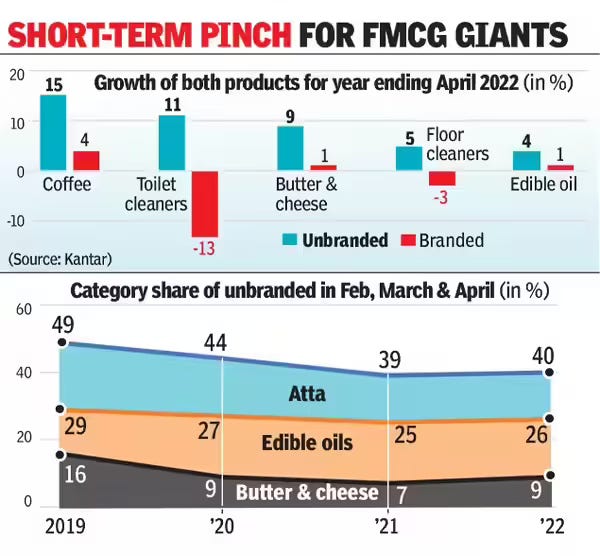From maska1 to masalas, Indians buy more unbranded products than branded. Not just that, there are entire categories that only the top 1-10% have tried.

The only way for brands to grow here is by increasing trials, i.e. new household penetration. Yet, the reality is that the average cash poor householder will need 200% conviction that this additional purchase is worth it.
Speaking of “worth it”, my first job was as a sales officer with L’Oréal. A senior sales officer, Ajay, was training me. In my first week, we had to go on a rescue mission. A new launch, L’Oréal Hair Mascara2, was in trouble. Product was not moving off the shelves, and retailers wanted to return the stock. Our mission was to convince retailers to give it another shot, because if they refused, the returns would badly impact our sales target achievement.
Shop after shop, retailers refused to place orders for other products and complained bitterly about how Hair Mascara was not selling. They said their investment was stuck because consumers did not know how to use this ‘new-fangled’ product.
In a last-ditch attempt to convince one retailer to wait for some more time, Ajay took a lock of my hair and, with a grand flourish, smeared hair mascara on it. Startled, I snapped, “Oh, don’t spoil my hair!”. The retailer won that round, and we had to take his stock back that very day.
From hair mascara rejecter to heavy hair products user
In that moment, I had reacted as a consumer, not as a responsible sales officer.
Like most Indians of my generation, I believed that using hair colour, hair dryers, or chemicals caused irreversible harm to hair. So when colour touched my hair, I panicked because I thought my hair’s health was doomed!
Ironically, I later went on to become the Product Executive for the Excellence Hair Colour Brand. And so the second time I tried hair colour was a year later, when we were launching Excellence Hair Colour in shades of red. We needed to test the new shades on Indian hair, and I became a reluctant guinea pig3.
After the colour and styling, my hair looked great, and I experienced firsthand what we wanted our consumers to feel – how much of a confidence-booster great-looking hair can be!
Since my hair did not fall off or get damaged, I knew that my fears had been unfounded.
Two ‘forced’ samplings later, I have never looked back. I have since experimented with my hair constantly. Straightened it, styled it, got streaks, cut it short, grown it long, deep conditioned it, and even botoxed it. I own at least 15 hair care products, plus a Phillips hair straightening iron AND a straightening brush. From a complete non-user, I became a heavy user of not just hair colour, but also adjacent hair product categories.
And therein are the golden rules for marketers in India
- Forced usage bridges the chasm between non-triers and loyalty: When I experienced the product, my resistance evaporated. Sampling is especially relevant for underdeveloped markets, and even for expensive products.
- More exposure translates into deeper usage. But only if the product is good: Once consumers try a product, and IF the product is good, their barriers fade over time. They buy more of the product and even start exploring adjacent categories.
- More than one trial might be needed to break through: Salesforce reports that in a B2B situation, it takes 6–8 marketing contacts to convert to a sale. Inertia is hard to pierce; this is where consistency in sampling efforts compounds.
There are many ways to skin the cat
- Food and beverage brands build free samples cost into their P&L. Even after 100 years alive, established brands like Coke continue to sample their products to refresh desire and to target newly minted teenagers.
- Demonstrations in Public places like malls are common for white goods brands like Samsung or X-Box.
- Expensive products like Dyson offer free demos at home. When we saw the bag full of skin cells and dust Dyson had sucked out of our mattresses, we had to buy its superpower.
- Premium personal care brands give free sachets and small bottles with each purchase, to get the same consumer to buy adjacent products
- Services like Gmail launched with exclusive invitations. Once people tried the email service, they liked the product enough to continue and also spread word of mouth.
Thanks for reading!
More ways to connect
- Watch my Tedx talk
- Connect on LinkedIn
- read the Archives
- Subscribe to this Newsletter
1 butter
2 Hair Mascara was ‘make-up’ for the hair – a temporary (wash-off) hair colour that came in 8 luminous colours. Youth and teens could add streaks of funky colour for parties or to look special any day of the week.
3 In L’Oréal parlance, I had ‘virgin’ hair — hair that had never been treated with colour or chemicals (for straightening or perming). New hair colours are best tested on virgin hair.
